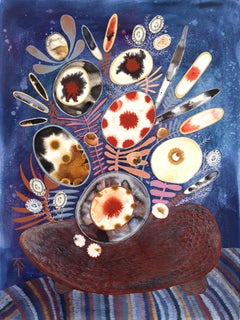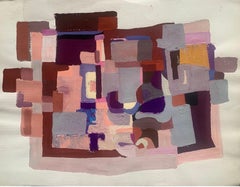Paulino Medina Abstract Drawings and Watercolors
to
1
Overall Width
to
Overall Height
to
1
1
1
1
1
2
138
110
89
77
1
Artist: Paulino Medina
Abstract Watercolor Painting
By Paulino Medina
Located in Houston, TX
One-of-a-kind abstract watercolor bursting with bright hues, features various swirling shapes overlapping one another by artist Paulino Medina Sosa, 2012. Signed lower left.
Origina...
Category
21st Century and Contemporary Paulino Medina Abstract Drawings and Watercolors
Materials
Paper, Watercolor
Related Items
Flower Arrangement in Carved Wooden Bowl - Abstract Botanical Painting on Paper
Located in Los Angeles, CA
Krisanne Souter weaves together elements of nature and ancient feminine archetypes, such as the Mother and the Mystic. Botanical themes, playful elements, and unexpected surprises ar...
Category
21st Century and Contemporary Abstract Paulino Medina Abstract Drawings and Watercolors
Materials
Paper, Ink, Acrylic, Watercolor, Color Pencil
Abstract Geometric Composition. Second half of the 20th century
Located in Firenze, IT
Abstract Geometric Composition
Date: Second half of the 20th century
Medium: Gouache on paper
Dimensions: H 50 cm x W 65 cm approx.
Description: Modular geometric structure with ove...
Category
Late 20th Century Abstract Geometric Paulino Medina Abstract Drawings and Watercolors
Materials
Paper, Gouache
$200 Sale Price
20% Off
H 19.69 in W 25.6 in
Neptune Flower Arrangement - Abstract Botanical Mixed Media Painting on Paper
Located in Los Angeles, CA
Krisanne Souter weaves together elements of nature and ancient feminine archetypes, such as the Mother and the Mystic. Botanical themes, playful elements, and unexpected surprises ar...
Category
21st Century and Contemporary Abstract Paulino Medina Abstract Drawings and Watercolors
Materials
Paper, Ink, Acrylic, Watercolor, Color Pencil
'Fish, Dove and Musical Instrument', Italian School (circa 1940s)
Located in London, GB
'Fish, Dove and Musical Instrument', gouache on paper, from the Italian School of artists (circa 1940s). Surely this very attractive piece was inspired by Georges Braque (1882-1963) ...
Category
1940s Modern Paulino Medina Abstract Drawings and Watercolors
Materials
Paper, Gouache
$1,640
H 23.63 in W 17.33 in
"Burst of Creativity" (contemporary impressionist floral painting on paper)
Located in VÉNISSIEUX, FR
In this floral artwork I experience the world of nature through the bright colors of a summer period.
While painting, I sought to capture the beauty of summer flowers which are full...
Category
2010s Impressionist Paulino Medina Abstract Drawings and Watercolors
Materials
Paper, Acrylic, Watercolor
$132 Sale Price
46% Off
H 11.7 in W 8.27 in D 0.04 in
Composition with Circles II
By James Pichette
Located in London, GB
'Composition with Circles II', gouache on art paper, by James Pichette. A dynamic, lively abstract composition by an artist known for such stunning, viv...
Category
1970s Abstract Paulino Medina Abstract Drawings and Watercolors
Materials
Paper, Gouache
1950s "Sitting in Chair" Mid Century Figurative Pratt Graphic Arts Center
By Donald Stacy
Located in Arp, TX
Donald Stacy
"Sitting in Chair"
c.1950s
Gouache and oil pastel on paper
24" x 18" unframed
Came from artist's estate
*Custom framing available for additio...
Category
Mid-20th Century American Modern Paulino Medina Abstract Drawings and Watercolors
Materials
Paper, Oil Pastel, Gouache
$570 Sale Price
40% Off
H 18 in W 24 in
"Sleeping Figures" Watercolor Abstract Painting 10" x 14"in by Shaker El Maadawy
Located in Culver City, CA
"Sleeping Figures" Watercolor Abstract Painting 10" x 14"in by Shaker El Maadawy
signed & dated
Shaker El Maadawy graduated from the Faculty of Fine Arts in painting in 1967 in his...
Category
20th Century Abstract Expressionist Paulino Medina Abstract Drawings and Watercolors
Materials
Paper, Watercolor
"Luminosity"
Located in VÉNISSIEUX, FR
In my art practice I love to use bright colors which boldly contrast with complementary colors so I could get unusual original compositions and structures.
The objective of this ar...
Category
2010s Abstract Impressionist Paulino Medina Abstract Drawings and Watercolors
Materials
Paper, Acrylic, Watercolor
"Wonderful floral glow"
Located in VÉNISSIEUX, FR
In this abstract floral artwork I experience the world of nature through the bright colors of a summer period.
While painting, I sought to capture the beauty of summer flowers whic...
Category
2010s Abstract Impressionist Paulino Medina Abstract Drawings and Watercolors
Materials
Paper, Acrylic, Watercolor
"Summer table" (contemporary impressionist still-life acrylic painting on paper)
Located in VÉNISSIEUX, FR
In this abstract still-life floral artwork "Summer table" I experience the world of nature through the bright colors of a summer period.
While painting, I sought to capture the beau...
Category
2010s Contemporary Paulino Medina Abstract Drawings and Watercolors
Materials
Paper, Acrylic, Watercolor
$146 Sale Price
30% Off
H 11.7 in W 8.27 in D 0.04 in
"Water lilies" ( contemporary acrylic colorful impressionst painting on paper)
Located in VÉNISSIEUX, FR
In my art practice I love to use bright colors which boldly contrast with complementary colors so I could get unusual original compositions and structures.
The objective of this art...
Category
2010s Impressionist Paulino Medina Abstract Drawings and Watercolors
Materials
Paper, Acrylic, Watercolor
$175 Sale Price
30% Off
H 11.7 in W 8.27 in D 0.04 in
Paulino Medina abstract drawings and watercolors for sale on 1stDibs.
Find a wide variety of authentic Paulino Medina abstract drawings and watercolors available for sale on 1stDibs. You can also browse by medium to find art by Paulino Medina in paint, paper, watercolor and more. Not every interior allows for large Paulino Medina abstract drawings and watercolors, so small editions measuring 1 inch across are available. Customers who are interested in this artist might also find the work of Renato Garza Cervera, Amy Williams, and Aleksander Grzybek. Paulino Medina abstract drawings and watercolors prices can differ depending upon medium, time period and other attributes. On 1stDibs, the price for these items starts at $250 and tops out at $250, while the average work can sell for $250.

